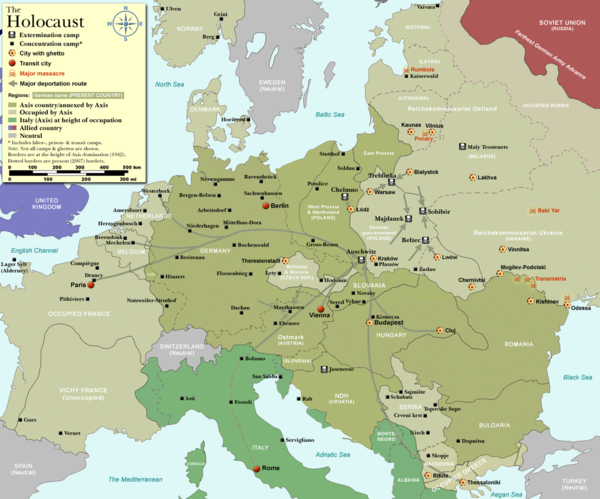Difference between revisions of "Nazi Ghettos"
| Line 10: | Line 10: | ||
Initially the ghettos were given some appearance of self-government under a Jewish Council and a Jewish police. Schools, hospitals and orphanages were organized for children. | Initially the ghettos were given some appearance of self-government under a Jewish Council and a Jewish police. Schools, hospitals and orphanages were organized for children. | ||
The brutal living conditions in the ghettos made vain any | The brutal living conditions in the ghettos, however, made soon vain any hope of a "normal" life. The Jews were not allowed out of the ghetto, so they had to rely on smuggling and the starvation rations supplied by the Nazis: in Warsaw this was 253 calories (1,060 kJ) per Jew, compared to 669 calories (2,800 kJ) per Pole and 2,613 calories (10,940 kJ) per German (the minimum recommended for an healthy life is 1,200). With the crowded living conditions, starvation diets, and insufficient sanitation (coupled with lack of medical supplies), epidemics of infectious disease became a major feature of ghetto life. before July 1942, 20% of residents died of 'natural' causes: some 43,800 in the Łódź Ghetto, 76,000 in the Warsaw Ghetto ... | ||
The children and the elderly were the ones who suffered mostly from the brutal living conditions in the ghetto. Children died from starvation and diseases as well as lack of adequate clothing and shelter. | The children and the elderly were the ones who suffered mostly from the brutal living conditions in the ghetto. Children died from starvation and diseases as well as lack of adequate clothing and shelter. | ||
Revision as of 13:17, 11 February 2020
Soon after the 1939 German invasion of Poland, the Nazis began to force Jews to live in designate areas, or ghettos.
Hundreds of ghettos were established. In most cases they functioned only as a temporary concentration of the local Jewish population before moving them to the major urban ghettos or directly to killing centers (designed areas in the woods or death camps). The major ghettos were those in Warsaw (500.000 people), Lodz, Krakow, Lvov, Bialystok, Lakhva in Poland; Kaunas and Vilnius in Lithuania; Budapest and Cluj in Hungary; Theresienstadt in Czechia.
Living conditions
Initially the ghettos were given some appearance of self-government under a Jewish Council and a Jewish police. Schools, hospitals and orphanages were organized for children.
The brutal living conditions in the ghettos, however, made soon vain any hope of a "normal" life. The Jews were not allowed out of the ghetto, so they had to rely on smuggling and the starvation rations supplied by the Nazis: in Warsaw this was 253 calories (1,060 kJ) per Jew, compared to 669 calories (2,800 kJ) per Pole and 2,613 calories (10,940 kJ) per German (the minimum recommended for an healthy life is 1,200). With the crowded living conditions, starvation diets, and insufficient sanitation (coupled with lack of medical supplies), epidemics of infectious disease became a major feature of ghetto life. before July 1942, 20% of residents died of 'natural' causes: some 43,800 in the Łódź Ghetto, 76,000 in the Warsaw Ghetto ...
The children and the elderly were the ones who suffered mostly from the brutal living conditions in the ghetto. Children died from starvation and diseases as well as lack of adequate clothing and shelter.
In spite of their acute vulnerability, children discovered ways to survive. Children smuggled food and medicine into the ghettos, in turn smuggling out their own personal possessions to trade for said goods. Children in youth movements later escaped the ghettos to join underground resistance activities such as Soviet partisan units; and lived as street children or in hiding, hosted to non-Jewish families.
In order to avoid deportation of the unemployed, many children tried to enroll as forced labor, as long as 12 hours a day.
The killing
Starting from 1942, the Nazis began the liquidation of the ghetto, first through mass shootings in the East, then with the establishment of death camps. Chelmno (Lodz), Treblinka (Warsaw and Bialystok), Sobibor, Belzec (Lvov), Majdanek, Auschwitz. The children and the elderly were the first to be eliminated. Orphanages and child hospitals in the ghettos were the first to be closed and all the residents killed or sent to extermination.
